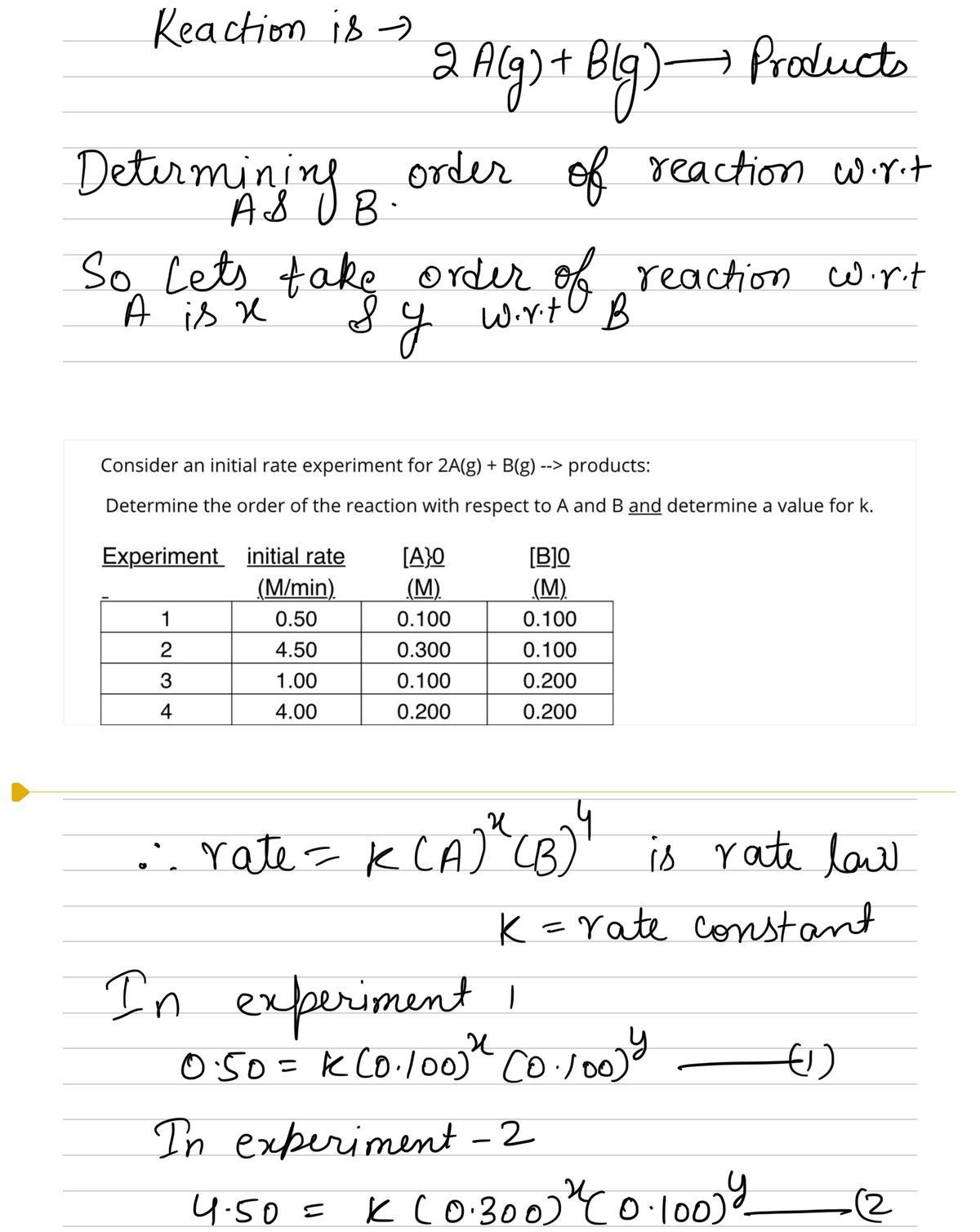Consider an initial rate experiment for 2A(g) + B(g) --> products: Determine the order of the reaction with respect to A and B and determine a value for k. Experiment initial rate (M/min) [A}O (M) [B]O (M) 1 0.50 0.100 0.100 4.50 0.300 0.100 3 1.00 0.100 0.200 4 4.00 0.200 0.200
Consider an initial rate experiment for 2A(g) + B(g) --> products: Determine the order of the reaction with respect to A and B and determine a value for k. Experiment initial rate (M/min) [A}O (M) [B]O (M) 1 0.50 0.100 0.100 4.50 0.300 0.100 3 1.00 0.100 0.200 4 4.00 0.200 0.200
Related questions
Question
Consider an initial rate experiment for 2A(g) + B(g) --> products:
Determine the order of the reaction with respect to A and B and determine a value for k.
![### Initial Rate Experiment for the Reaction 2A(g) + B(g) → Products
This experiment aims to determine the order of the reaction with respect to reactants A and B, as well as calculate the rate constant \( k \).
#### Experimental Data:
| Experiment | Initial Rate (M/min) | \([A]_0\) (M) | \([B]_0\) (M) |
|------------|----------------------|----------------|---------------|
| 1 | 0.50 | 0.100 | 0.100 |
| 2 | 4.50 | 0.300 | 0.100 |
| 3 | 1.00 | 0.100 | 0.200 |
| 4 | 4.00 | 0.200 | 0.200 |
### Analysis:
1. **Order with respect to A:**
- Compare Experiments 1 and 2: Doubling \([A]_0\) from 0.100 M to 0.300 M while keeping \([B]_0\) constant increases the rate from 0.50 M/min to 4.50 M/min.
2. **Order with respect to B:**
- Compare Experiments 1 and 3: Doubling \([B]_0\) from 0.100 M to 0.200 M while keeping \([A]_0\) constant increases the rate from 0.50 M/min to 1.00 M/min.
By analyzing these changes in initial rates, the respective orders of the reaction with respect to A and B can be determined, followed by calculation of the rate constant \( k \) using the rate law expression.](/v2/_next/image?url=https%3A%2F%2Fcontent.bartleby.com%2Fqna-images%2Fquestion%2F1dd351b3-52c1-452a-96ee-ed63b06ec483%2F01035946-9c47-47ed-af6c-3e8921be57b4%2Fbvmp7we_processed.jpeg&w=3840&q=75)
Transcribed Image Text:### Initial Rate Experiment for the Reaction 2A(g) + B(g) → Products
This experiment aims to determine the order of the reaction with respect to reactants A and B, as well as calculate the rate constant \( k \).
#### Experimental Data:
| Experiment | Initial Rate (M/min) | \([A]_0\) (M) | \([B]_0\) (M) |
|------------|----------------------|----------------|---------------|
| 1 | 0.50 | 0.100 | 0.100 |
| 2 | 4.50 | 0.300 | 0.100 |
| 3 | 1.00 | 0.100 | 0.200 |
| 4 | 4.00 | 0.200 | 0.200 |
### Analysis:
1. **Order with respect to A:**
- Compare Experiments 1 and 2: Doubling \([A]_0\) from 0.100 M to 0.300 M while keeping \([B]_0\) constant increases the rate from 0.50 M/min to 4.50 M/min.
2. **Order with respect to B:**
- Compare Experiments 1 and 3: Doubling \([B]_0\) from 0.100 M to 0.200 M while keeping \([A]_0\) constant increases the rate from 0.50 M/min to 1.00 M/min.
By analyzing these changes in initial rates, the respective orders of the reaction with respect to A and B can be determined, followed by calculation of the rate constant \( k \) using the rate law expression.
Expert Solution
Step 1

Step by step
Solved in 3 steps with 3 images
